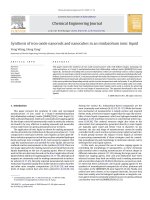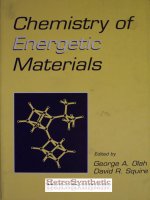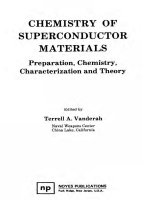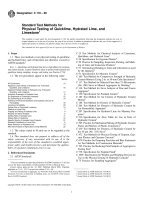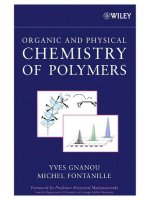Physical chemistry of ionic materials ions and electrons in solids
Bạn đang xem bản rút gọn của tài liệu. Xem và tải ngay bản đầy đủ của tài liệu tại đây (21.54 MB, 538 trang )
www.pdfgrip.com
Physical Chemistry of Ionic Materials: Ions and Electrons in Solids.
Joachim Maier
Copyright 2004 John Wiley & Sons, Ltd. ISBNs: 0-470-99991-1 (HB); 0-470-87076-1 (PB)
www.pdfgrip.com
www.pdfgrip.com
www.pdfgrip.com
www.pdfgrip.com
www.pdfgrip.com
www.pdfgrip.com
Contents
Introduction
1.1 Motivation
1.2 The defect concept: Point defects as the main actors . . .
11
11
14
2 Bonding aspects: From atoms to solid state
2.1 Chemical bonding in simple molecules
2.1.1 Ideal covalent bonding .
2.1.2 Polar covalent bonding
2.1.3 The ionic bonding
2.1.4 Metallic bonding
2.1.5 Further intermediate forms of chemical bonding . .
2.1.6 Two-body potential functions
2.2 Many atoms in contact: The solid state as a giant molecule
2.2.1 The band model
2.2.2 Ionic crystals
2.2.3 Molecular crystals
2.2.4 Covalent crystals
2.2.5 Metallic crystals
2.2.6 Mixed forms of bonding in solids
2.2.7 Crystal structure and solid state structure
23
23
23
27
30
31
32
33
35
36
50
56
57
59
60
61
3
65
65
69
1
Phonons
3.1 Einstein and Debye models
3.2 Complications
4 Equilibrium thermodynamics of the perfect solid
4.1 Preliminary remarks
4.2 The formalism of equilibrium thermodynamics
4.3 Examples of equilibrium thermodynamics
4.3.1 Solid-solid phase transition
4.3.2 Melting and evaporation
4.3.3 Solid-solid reaction
<
4.3.4 Solid-gas reaction
72
72
72
86
86
88
89
89
www.pdfgrip.com
Contents
4.3.5
4.3.6
4.3.7
4.3.8
Phase equilibria and mixing reactions
Spatial equilibria in inhomogeneous systems
Thermodynamics of elastically deformed solids
The thermodynamic functions of state of the perfect solid . . .
93
100
103
104
5 Equilibrium thermodynamics of the real solid
108
5.1 Preliminary remarks
108
5.2 Equilibrium thermodynamics of point defect formation
109
125
5.3 Equilibrium thermodynamics of electronic defects
134
5.4 Higher-dimensional defects
134
5.4.1 Equilibrium concentration
136
5.4.2 Dislocations: Structure and energetics
140
5.4.3 Interfaces: Structure and energetics
5.4.4 Interfacial thermodynamics and local mechanical equilibria . . 146
155
5.5 Point defect reactions
155
5.5.1 Simple internal defect equilibria
161
5.5.2 External defect equilibria
177
5.6 Doping effects
200
5.7 Interactions between defects
201
5.7.1 Associates
210
5.7.2 Activity coefficients
217
5.8 Boundary layers and size effects
217
5.8.1 General
223
5.8.2 Concentration profiles in the space charge zones
228
5.8.3 Conductivity effects
233
5.8.4 Defect thermodynamics of the interface
241
5.8.5 Examples and supplementary comments
6
Kinetics and irreversible thermodynamics
268
6.1 Transport and reaction
268
6.1.1 Transport and reaction in the light of irreversible
269
thermodynamics
6.1.2 Transport and reaction in the light of chemical
275
kinetics
283
6.2 Electrical mobility
283
6.2.1 Ion mobility
292
6.2.2 Electron mobility
294
6.3 Phenomenological diffusion coefficients
295
6.3.1 Ion conduction and self-diffusion
296
6.3.2 Tracer diffusion
300
6.3.3 Chemical diffusion
6.3.4 A comparison of the phenomenological diffusion coefficients . . 305
307
6.4 Concentration profiles
www.pdfgrip.com
Contents
6.5
6.6
Diffusion kinetics of stoichiometry change
Complications of matter transport
6.6.1 Internal interactions
6.6.2 Boundary layers and grain boundaries
6.7 Surface reactions
6.7.1 Elementary processes
6.7.2 Coupled reactions
6.7.3 Phenomenological rate constants
6.7.4 Reactivity, chemical resistance and chemical capacitance . .
6.8 Catalysis
6.9 Solid state reactions
6.9.1 Fundamental principles
6.9.2 Morphological and mechanistic complications
6.10 Nonlinear phenomena
6.10.1 Irreversible thermodynamics and chemical kinetics far from
equilibrium, and the special role of autocatalysis
6.10.2 Nonequilibrium structures in time and space
6.10.3 The concept of fractal geometry
9
312
319
319
332
338
338
340
347
361
362
367
367
378
382
382
388
393
7 Solid state electrochemistry:
399
Measurement techniques and applications
7.1 Preliminary remarks:
399
Current and voltage in the light of defect chemistry
404
7.2 Open circuit cells
7.2.1 Equilibrium cells:
Thermodynamic measurements and potentiometric sensors . 404
7.2.2 Permeation cells and chemical polarization:
Measurement of transport parameters and chemical filters . 413
418
7.3 Cells under current load
7.3.1 Electrochemical pumps, conductivity sensors and other
418
applications
424
7.3.2 Measurement cells
426
7.3.3 Bulk and phase boundary effects
444
7.3.4 Stoichiometry polarization
460
7.3.5 Coulometric titration
462
7.3.6 Impedance spectroscopy
7.3.7 Inhomogeneities and heterogeneities:
473
Many-point measurements and point electrodes
481
7.4 Cells generating current
481
7.4.1 General
482
7.4.2 Fuel cells
487
7.4.3 Batteries
495
7.4.4 Tables .
www.pdfgrip.com
10
8
Contents
Bibliography
Index
500
527
www.pdfgrip.com
Physical Chemistry of Ionic Materials: Ions and Electrons in Solids.
Joachim Maier
Copyright 2004 John Wiley & Sons, Ltd. ISBNs: 0-470-99991-1 (HB); 0-470-87076-1 (PB)
www.pdfgrip.com
www.pdfgrip.com
www.pdfgrip.com
www.pdfgrip.com
www.pdfgrip.com
www.pdfgrip.com
www.pdfgrip.com
www.pdfgrip.com
www.pdfgrip.com
www.pdfgrip.com
www.pdfgrip.com
www.pdfgrip.com
Physical Chemistry of Ionic Materials: Ions and Electrons in Solids.
Joachim Maier
Copyright 2004 John Wiley & Sons, Ltd. ISBNs: 0-470-99991-1 (HB); 0-470-87076-1 (PB)
www.pdfgrip.com
